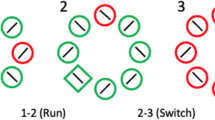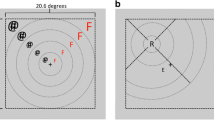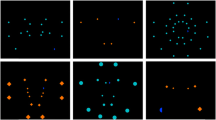Summary
In the literature two different views on the time course of activation of “recognition units” — hypothetical units that represent identity information — are proposed. The first view assumes that the recognition units accumulate activation gradually over time. The second assumes that the activation levels increase fast initially and then start to decrease. Hagenzieker and Van der Heijden (1990) have proposed a more general information-processing model, which is compatible with both views. In this model a treshold determines what type of time course will be obtained. For below-threshold-activation values a gradual accumulation of activation will be found; for above-threshold values activation levels will first increase and then, because of inhibition, decrease. This model served as a starting-point for the present paper. Elaboration of this model led to two testable hypotheses with regard to identification performance. The first prediction is that evidence for inhibition should be observed only under relatively bright luminance conditions. The second is that, given inhibition, the amount of the effect of this inhibition should increase over time. A partial-report bar-probe task was used to test the predictions. The experiment involved two luminance conditions and the information was sampled at two different moments in time. To control for possible localization artefacts a digit-naming task was also used. Evidence for inhibition was found in both luminance conditions. In accordance with the model the amount of the effect of inhibition increased over time.
Similar content being viewed by others
References
Averbach, E., & Coriell, A. S. (1961). Short-term memory in vision.Bell System Technical Journal, 40, 309–328.
Bouma, H. (1970). Interaction effects in parafoveal letter recognition.Nature, 226, 177–178.
Broca, A., & Sulzer, D. (1902). La sensation lumineuse en fonction du temps.Comptes Rendus de Séances de la Société de Biologie (Paris), 37, 493–495.
Coltheart, M. (1984). Sensory memory — A tutorial review. In H. Bouma & D. G. Bouwhuis (Eds.),Attention and performance X, Control of language processes. London: Lawrence Erlbaum.
Estes, W. K. (1978). Perceptual processing in letter recognition and reading. In E. C. Carterette & M. P. Friedman (Eds).,Handbook of perception, Vol. IX. New York: Academic Press.
Hagenaar, R. (1990). The partial-report bar-probe task and its errors (in preparation).
Hagenzieker, M. P., & Van der Heijden, A. H. C. (1990). Time courses in visual information processing: Some theoretical considerations.Psychological Research, 52, 5–12
Kahnemann, D. (1973).Attention and effort. Englewood Cliffs, NJ: Prentice Hall.
Marr, D. (1980). Visual information processing: The structure and creation of visual representations.Philosophical Transactions of the Royal Society, London, B290, 199–218.
Mewhort, D. J. K., & Campbell, A. J. (1978). Processing spatial information and the selective masking effect.Perception & Psychophysics, 24(1), 93–101.
Mewhort, D. J. K., Campbell, A. J., Marchetti, F. M., & Campbell, J. I. D. (1981). Identification, localization, and “iconic memory”: An evaluation of the bar-probe task.Memory & Cognition, 9, 50–67.
Tramer, S. (1981). Data versus probe errors in the bar-probe task: A re-evaluation of the dual-buffer model. Unpublished MA thesis, Queen's University at Kingston.
Van der Heijden, A. H. C. (1987). Central selection in vision. In H. Heuer & A. F. Sanders (Eds.),Issues in perception and action. Hillsdale, NJ: Erlbaum.
Author information
Authors and Affiliations
Rights and permissions
About this article
Cite this article
Hagenzieker, M.P., van der Heijden, A.H.C. & Hagenaar, R. Time courses in visual-information processing: Some empirical evidence for inhibition. Psychol. Res 52, 13–21 (1990). https://doi.org/10.1007/BF00867206
Received:
Accepted:
Issue Date:
DOI: https://doi.org/10.1007/BF00867206




